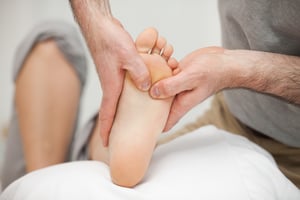 10,000 steps per day has become the goal for many Americans who are strapping on their FitBit or Apple Watch and attempting to be the healthiest versions of themselves. This magic number adds up to about 5 miles and is supposed to help keep us active and our bodies strong and protected against illness. However, when hindered by something like foot pain, any amount of walking can seem a tall task, much less the recommended 10,000 steps. In order to recover from foot pain and get moving again, patients will first need to understand the source of their discomfort.
10,000 steps per day has become the goal for many Americans who are strapping on their FitBit or Apple Watch and attempting to be the healthiest versions of themselves. This magic number adds up to about 5 miles and is supposed to help keep us active and our bodies strong and protected against illness. However, when hindered by something like foot pain, any amount of walking can seem a tall task, much less the recommended 10,000 steps. In order to recover from foot pain and get moving again, patients will first need to understand the source of their discomfort.
Plantar Fasciitis and Bottom of Foot Pain
The fascia is a thick band of tissue running the length of the bottom of the foot that provides support for the arch. Overuse or overextension of this tissue can result in microtearing and painful irritation and inflammation. The injury often presents with “first step” pain, or pain that is at its worst when taking your first steps in the morning. Typically, this pain is sharp or stabbing and located at the bottom of the heel where the fascia connects to the bone.
Toe Pain from Bunions
Bunions are painful, bony bumps that arise at the base of the big toe. This occurs when the largest joint in the big toe, the metatarsophalangeal joint (MTP), is out of alignment. As a result, the MTP protrudes from the side of the toe and becomes enlarged and inflamed. Ill-fitting shoes are often a cause of bunions, but they may also be hereditary or the result of an inflammatory condition such as rheumatoid arthritis.
Arch-Related Pain
A normal arch provides the foot with just the right amount support and alignment during activities such as running. However, there are many whose arches fall out of the range of “normal.” High arches can place excessive strain on the muscles and joints of the foot and many not absorb shock as well. Low arches, or flatfeet, can also cause muscular stress and the feet are likely to pronate (roll in) when walking or running. Both of these foot conditions can lead to foot pain, particularly when appropriate footwear is not chosen. Patients should take care to select shoes with just the right amount of support for their arch type and should consider custom orthotics as well.
Pain from Heel Spurs
Bone spurs are calcium deposits that lead to protrusions of bone. These develop over time to compensate for an underlying trauma or condition. Overextension of the fascia, for instance, can lead to the development of bone spurs on the underside of the heel. They may also develop in response to degeneration of the joint through arthritis.
Morton’s Neuroma Foot Pain
Morton’s Neuroma is a condition that most commonly occurs between the third and fourth toes. It occurs when friction between bones leads to thickening of tissue around one of nerves in your foot. This leads to a sharp, burning sensation and may also cause numbness and tingling. Many patients also describe the sensation of standing on a pebble underneath the affected area.
Foot pain can be mild, severe, occasional, or chronic. No matter how your own foot pain presents, having it properly diagnosed and treated can help the condition resolve and prevent worsening in the future. Schedule an appointment with a podiatrist to learn more about your pain and how it may be treated.



.png?width=110&height=110&name=lane%20badge%20(1).png)
